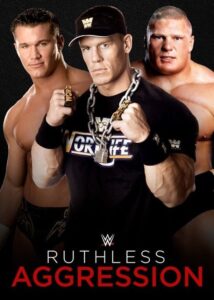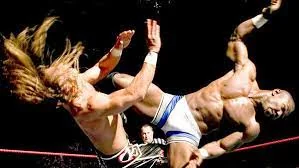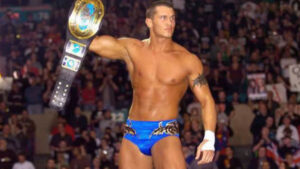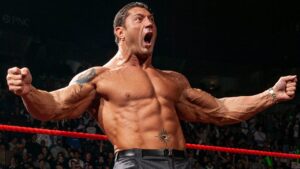The Ruthless Aggression Era (2002–2008) was a transformative period in WWE history, marking the company’s evolution following the end of its fierce rivalry with WCW during the Monday Night Wars. This era introduced new stars, redefined wrestling style, and built on the foundations laid by the Attitude Era. In this article, we’ll explore how the Ruthless Aggression Era began, what made it unique, its most important figures, and what led to its conclusion.

Table of Contents
ToggleHow the Ruthless Aggression Era Started
The Ruthless Aggression Era began in 2002, after the dissolution of WCW in 2001 left WWE as the dominant force in professional wrestling. The Attitude Era, characterized by edgier content, was winding down, and WWE faced the challenge of keeping its product fresh without the competition from WCW pushing it to innovate.
Vince McMahon, WWE’s chairman, delivered a memorable promo on June 24, 2002, where he declared that it was time for “Ruthless Aggression” to usher in a new age. This declaration set the tone for the next several years, emphasizing the need for younger stars to step up and seize opportunities in a wrestling world that was now theirs to dominate.
What Made the Ruthless Aggression Era Unique?
1. A Focus on New Talent
One of the hallmarks of the Ruthless Aggression Era was the push to develop new, young stars. With the departures of big names like Stone Cold Steve Austin and The Rock pursuing a Hollywood career, WWE had to build a fresh roster of main-event talent. Superstars like John Cena, Brock Lesnar, Randy Orton, and Batista were given the opportunity to rise to the top, shaping the future of WWE.

2. A Shift in In-Ring Style
Compared to the wild and sometimes chaotic nature of the Attitude Era, the Ruthless Aggression Era saw a shift toward a more athletic, technically sound wrestling style. There was still plenty of over-the-top entertainment, but the focus was often on the physicality and ability of the wrestlers inside the ring. Matches became more intense, with superstars like Kurt Angle, Eddie Guerrero, and Chris Benoit known for their technical prowess and putting on classic bouts.

3. Brand Extension: SmackDown vs. Raw
In 2002, WWE introduced the “brand split,” creating distinct rosters for its two main shows, Monday Night Raw and SmackDown. This move was partly to create fresh rivalries and give younger talent more screen time. The brand split introduced a competitive dynamic between Raw and SmackDown, with each show developing its own identity and signature stars. This separation allowed WWE to create unique storylines and develop talent at a faster pace.

4. Evolution of the Women’s Division
The Ruthless Aggression Era also witnessed the continued evolution of women’s wrestling. Stars like Trish Stratus, Lita, and later on, Mickie James and Victoria, proved that women could deliver just as much action and storytelling as their male counterparts. While the division still had its share of “diva” storylines, these women paved the way for the future of women’s wrestling in WWE.

5. Stronger Focus on International Expansion
During this period, WWE began focusing more on expanding its global reach. With new superstars gaining popularity internationally, WWE started to focus on building a global fan base. The company hosted more events overseas, including in countries like the United Kingdom, Japan, and India. This era marked the beginning of WWE’s efforts to become a global entertainment brand, which would later lead to a more diverse roster and fanbase.
Key Figures of the Ruthless Aggression Era
1. John Cena

No one represents the Ruthless Aggression Era more than John Cena. He made his WWE debut in 2002, answering Kurt Angle’s open challenge with the now-famous declaration of “Ruthless Aggression” while slapping Angle in the face. Cena quickly gained popularity with his “Doctor of Thuganomics” persona, rapping his way to stardom. By 2005, Cena had won his first WWE Championship, becoming the face of WWE for the next decade. His rise was a perfect reflection of Vince McMahon’s vision for the era: new, bold, and relentless.
2. Brock Lesnar

Known as “The Next Big Thing,” Brock Lesnar was another breakout star of the Ruthless Aggression Era. Lesnar debuted in 2002 and within five months won the WWE Championship, becoming the youngest WWE Champion at the time. His sheer athleticism, power, and in-ring ability made him an instant main-eventer. Lesnar’s dominance was undeniable, and he continued to be a force in the wrestling world, later transitioning to UFC, but his impact during this era remains legendary.
3. Randy Orton

The “Legend Killer” Randy Orton also made a name for himself during this era. As a third-generation wrestler, Orton had wrestling in his blood, but it was his cocky attitude, incredible athleticism, and his finishing move, the RKO, that catapulted him to the top. Orton became the youngest WWE World Heavyweight Champion at the age of 24, cementing his legacy as one of the era’s most significant figures.
4. Batista

Batista, also known as “The Animal,” emerged as one of the most powerful and imposing figures during the Ruthless Aggression Era. His time in the Evolution faction with Triple H, Randy Orton, and Ric Flair helped him develop into a main-event talent. Batista’s feud with Triple H, culminating at WrestleMania 21, where he won the World Heavyweight Championship, was a key moment of the era. Batista’s mix of brute strength and charisma made him a fan favorite.
5. Triple H

Although Triple H was already an established star before the Ruthless Aggression Era, he played a crucial role during this time. As the leader of Evolution, he helped groom future stars like Orton and Batista while maintaining his dominance in the main event scene. Triple H’s rivalries with Shawn Michaels, Chris Benoit, and others defined this period, and his influence as both a performer and backstage figure was undeniable.
6. Kurt Angle

A wrestling machine with unmatched in-ring ability, Kurt Angle was one of the top competitors during this era. His technical skill, mixed with his incredible intensity, made him one of WWE’s most reliable performers. Angle’s feuds with Brock Lesnar, Eddie Guerrero, and Shawn Michaels delivered some of the best matches of the era. His ability to be both a serious competitor and a comedic character added depth to WWE’s programming during this time.
7. Eddie Guerrero

Eddie Guerrero became one of the most beloved figures in WWE during the Ruthless Aggression Era. His “Lie, Cheat, and Steal” persona made him a fan favorite, and his in-ring skill was undeniable. Guerrero’s underdog victory at WrestleMania 20, where he won the WWE Championship, was one of the most heartwarming moments in WWE history. His tragic passing in 2005 left a huge void in the wrestling world, but his legacy continues to inspire.
The End of the Ruthless Aggression Era
By 2008, WWE began to shift its programming toward a more family-friendly product, ushering in what is known as the PG Era. This change was largely driven by WWE’s desire to appeal to a broader, younger audience and to attract more mainstream sponsors. The edgier content of the Ruthless Aggression Era was gradually toned down, and blood, harsh language, and some of the more extreme matches became less common. Also, the tragic suicide murder case of Chris Benoit turned the whole Trajectory of WWE at that time, this was the ultimate reason became to turning the programming to PG.
The departures of several key figures also contributed to the end of the Ruthless Aggression Era. Brock Lesnar left WWE in 2004, and by 2008, stars like Batista, Edge, and John Cena were evolving into leaders of the next generation of WWE programming. The PG Era officially began in July 2008, with a greater focus on entertainment that could be consumed by families and children.
Conclusion
The Ruthless Aggression Era was a vital period in WWE’s history, bridging the gap between the chaotic Attitude Era and the more controlled PG Era. It saw the emergence of future legends, the evolution of in-ring performance, and WWE’s continued expansion as a global entertainment powerhouse. Figures like John Cena, Brock Lesnar, Randy Orton, and Eddie Guerrero left an indelible mark on wrestling during this era, and many of today’s top stars trace their roots back to this transformative time.
As the industry evolved, so did WWE, but the influence of the Ruthless Aggression Era continues to be felt in today’s programming, where many of the stars who rose to prominence during this time are now veterans, still shaping the future of the business.
You can watch WWE ruthless aggression era documentary here
You can read our article on Attitude Era, Golden Era and New Generation era




